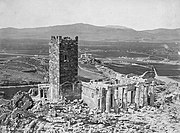Klepsydra (Acropolis)
Ancient well in Athens AcropolisThe Klepsydra of the Acropolis of Athens is a natural spring on the north-west slope of the Acropolis hill, near the intersection of the Peripatos and the Panathenaic Way. It had been in use as a source of water since prehistoric times but sometime in the fifth century BCE the site was developed with several new structures built. The site consisted of the paved court, a well, the covered well-house, a later Roman apsidal well house and a flight of stone-carved steps up to the Propylaea. There are several references to the source in ancient literature; Hesychius says of it “Klepsydra is a fountain which was formerly called Empedo”. Empedo, argues Parsons, was the name of the spring and Klepsydra the name given to the water made available by the fountain house. It would seem that Empedo was also the name of the tutelary deity of the spring – an Attic nymph. Mention is also made of the fountain by Aristophanes, Pausanias, and Plutarch.










